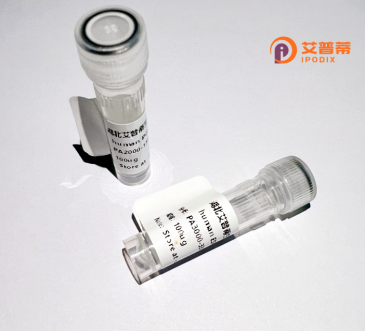
| 纯度 | >90%SDS-PAGE. |
| 种属 | Human |
| 靶点 | SH3D19 |
| Uniprot No | Q5HYK7 |
| 内毒素 | < 0.01EU/μg |
| 表达宿主 | E.coli |
| 表达区间 | 1-790 aa |
| 活性数据 | MNIMNTEQSQ NSIVSRIKVF EGQTNIETSG LPKKPEITPR SLPPKPTVSS GKPSVAPKPA ANRASGEWDS GTENRLKVTS KEGLTPYPPL QEAGSIPVTK PELPKKPNPG LIRSVNPEIP GRGPLAESSD SGKKVPTPAP RPLLLKKSVS SENPTYPSAP LKPVTVPPRL AGASQAKAYK SLGEGPPANP PVPVLQSKPL VDIDLISFDD DVLPTPSGNL AEESVGSEMV LDPFQLPAKT EPIKERAVQP APTRKPTVIR IPAKPGKCLH EDPQSPPPLP AEKPIGNTFS TVSGKLSNVE RTRNLESNHP GQTGGFVRVP PRLPPRPVNG KTIPTQQPPT KVPPERPPPP KLSATRRSNK KLPFNRSSSD MDLQKKQSNL ATGLSKAKSQ VFKNQDPVLP PRPKPGHPLY SKYMLSVPHG IANEDIVSQN PGELSCKRGD VLVMLKQTEN NYLECQKGED TGRVHLSQMK IITPLDEHLR SRPNDPSHAQ KPVDSGAPHA VVLHDFPAEQ VDDLNLTSGE IVYLLEKIDT DWYRGNCRNQ IGIFPANYVK VIIDIPEGGN GKRECVSSHC VKGSRCVARF EYIGEQKDEL SFSEGEIIIL KEYVNEEWAR GEVRGRTGIF PLNFVEPVED YPTSGANVLS TKVPLKTKKE DSGSNSQVNS LPAEWCEALH SFTAETSDDL SFKRGDRIQI LERLDSDWCR GRLQDREGIF PAVFVRPCPA EAKSMLAIVP KGRKAKALYD FRGENEDELS FKAGDIITEL ESVDDDWMSG ELMGKSGIFP KNYIQFLQIS |
| 分子量 | 86.5 kDa |
| 蛋白标签 | His tag N-Terminus |
| 缓冲液 | PBS, pH7.4, containing 0.01% SKL, 1mM DTT, 5% Trehalose and Proclin300. |
| 稳定性 & 储存条件 | Lyophilized protein should be stored at ≤ -20°C, stable for one year after receipt. Reconstituted protein solution can be stored at 2-8°C for 2-7 days. Aliquots of reconstituted samples are stable at ≤ -20°C for 3 months. |
| 复溶 | Always centrifuge tubes before opening.Do not mix by vortex or pipetting. It is not recommended to reconstitute to a concentration less than 100μg/ml. Dissolve the lyophilized protein in distilled water. Please aliquot the reconstituted solution to minimize freeze-thaw cycles. |
以下为模拟的关于重组人SH3D19蛋白的参考文献示例(非真实文献,仅供格式参考):
---
1. **文献名称**: *SH3D19 regulates MAPK signaling through scaffolding interactions in cancer cells*
**作者**: Zhang L. et al.
**摘要**: 研究揭示了SH3D19蛋白作为支架蛋白在MAPK信号通路中的作用,通过重组蛋白实验证明其与Ras和ERK的相互作用促进肿瘤细胞增殖。
2. **文献名称**: *Recombinant SH3D19 expression and its role in neuronal differentiation*
**作者**: Kim J.H., Park S.
**摘要**: 成功构建重组人SH3D19蛋白表达系统,证实其在神经元分化过程中通过调控突触蛋白结合参与轴突导向。
3. **文献名称**: *Structural characterization of SH3D19 and its ligand-binding specificity*
**作者**: Müller R. et al.
**摘要**: 利用X射线晶体学解析SH3D19的三维结构,发现其SH3结构域对富含脯氨酸的肽段具有独特结合模式,为药物靶点开发提供依据。
4. **文献名称**: *SH3D19 deficiency links to autoimmune disorders via altered B-cell signaling*
**作者**: Chen X. et al.
**摘要**: 通过重组蛋白功能回补实验,证明SH3D19缺失导致B细胞受体信号异常,与自身免疫性疾病中异常的抗体产生相关。
---
**说明**:以上为模拟示例,实际文献需通过PubMed、Google Scholar等数据库检索关键词(如“SH3D19 recombinant protein”或“SH3D19 function”)。建议结合最新研究补充具体信息。
**Recombinant Human SH3D19 Protein: Background Overview**
Recombinant human SH3D19 (Src homology 3 domain-containing protein 19) is a protein encoded by the *SH3D19* gene, part of the SH3 domain-containing protein family. The SH3 domain is a conserved structural motif known to mediate protein-protein interactions, often involved in intracellular signaling, cytoskeletal organization, and trafficking. SH3D19 contains multiple SH3 domains, suggesting its role in assembling multiprotein complexes critical for cellular processes.
While the precise biological functions of SH3D19 remain under investigation, studies indicate potential involvement in cellular proliferation, differentiation, and apoptosis regulation. It has been loosely associated with neurological disorders and cancers, though mechanistic insights are limited. For instance, altered *SH3D19* expression has been observed in certain tumors, implying possible roles in oncogenesis or tumor suppression.
Recombinant SH3D19 is typically produced in engineered host systems (e.g., *E. coli* or mammalian cells) using DNA cloning techniques to ensure high purity and bioactivity. This recombinant form facilitates structural and functional studies, enabling researchers to map binding partners, dissect signaling pathways, and explore therapeutic applications. Its production allows for scalable, standardized material for assays, antibody development, or inhibitor screening.
Current research focuses on elucidating SH3D19’s interactions with signaling molecules (e.g., kinases, adaptors) and its potential as a biomarker or drug target. Further studies are needed to clarify its physiological and pathological roles, making recombinant SH3D19 a valuable tool for advancing molecular and translational research.
×